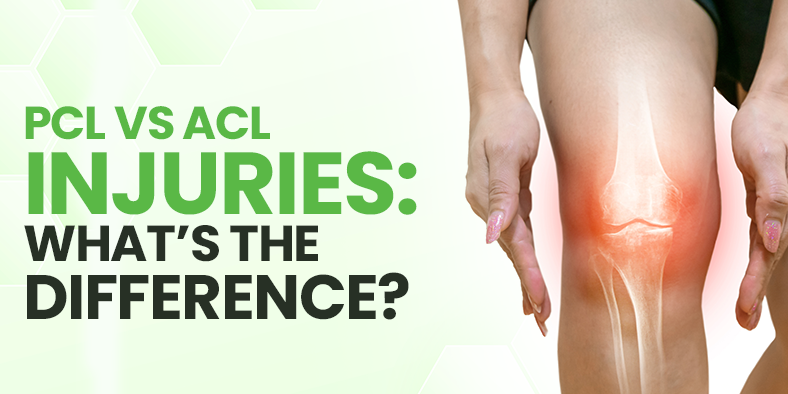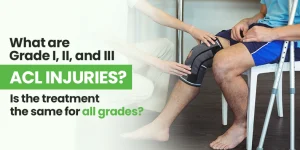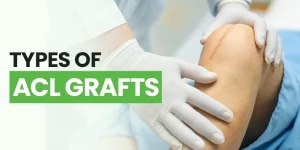For athletes, fitness freaks, or any individual who is involved in physical activities, it is common to experience knee injuries. PCL and ACL injuries are the most common types of knee injuries that these people go through.
These conditions refer to the tear or sprain in the two essential ligaments of the knee: ACL (Anterior Cruciate Ligament) and PCL (Posterior Cruciate Ligament).
Are these two the same, you may think? There is no doubt that both of these knee injuries impact knee stability and function. However, there is a huge difference between PCL and ACL injuries in terms of cause, symptoms, treatment, and recovery time.
This blog will help you understand the differences between the knee ligaments, PCL and ACL tear symptoms, and recovery times.
Keep reading till the end!
Understanding the Knee Ligaments
A knee is an important yet complex hinge joint. It connects the thigh bone (femur) to the shinbone (tibia). It relies on four main ligaments for stability:
- Anterior Cruciate Ligament (ACL)
- Posterior Cruciate Ligament (PCL)
- Medial Collateral Ligament (MCL)
- Lateral Collateral Ligament (LCL)
Among these 4 knee ligaments, ACL and PCL play an important role. It crosses each other in the middle of the knee, and forms an ‘X.’
These two ligaments work together for knee joint stability during movements.
Here is what ACL and PCL do at the time of movements:
- The ACL prevents the tibia from sliding too far forward.
- The PCL stops the tibia from moving too far backwards.
Irrespective of which ligament is injured out of these two, knee function can be compromised. However, they do not follow the same mechanism and management.
Causes of ACL and PCL Injuries
Here are the causes of PCL and ACL injuries:
ACL Injuries
Injuries to the ACL often occur during sudden movement. For instance, sudden changes in direction, awkward jump landings, quick stops, etc. ACL injuries are most common among sportspeople, especially those who play soccer, basketball, skiing, and football.
A few of the common causes include:
- A Sudden change in movements like pivoting or twisting.
- A rapid deceleration while running
- If jumping and landing incorrectly
- A direct blow to the side of the knee
PCL Injuries
PCL injuries, on the other hand, are caused by direct trauma or force to the front of the knee. It pushes the tibia backwards. These injuries are more common in car accidents or contact sports.
A few of the common causes include:
- A blow to the bent knee. For example, hitting the dashboard in a car crash.
- A fall on a bent knee
- Hyperextension injuries
Now, let’s move on to understanding the common symptoms and methods of diagnosing PCL and ACL injuries.
Symptoms and Diagnosis
The common PCL and ACL tear symptoms are as follows:
ACL Tear Symptoms:
- If you have experienced a loud “pop” sound at the time of injury.
- An immediate swelling and pain.
- An instability or “giving way” of the knee.
- Difficulty in bearing weight or walking.
- A loss of range of motion.
PCL Tear Symptoms:
- If you have mild to moderate swelling.
- If you have pain behind the knee.
- If you have trouble walking or bearing weight (though less severe than ACL injuries)
- If you have a feeling of instability, especially when walking downhill or on stairs
- A sense of stiffness in the knee joint
Here is how doctors diagnose PCL and ACL injuries:
Both injuries are diagnosed using a combination of:
- Physical examination (Lachman test for ACL, Posterior drawer test for PCL)
- Imaging tests like MRI and X-rays
- Patient history and symptom discussion
- Prompt diagnosis is key to preventing long-term damage and joint degeneration.
Treatment Options
There are different types of treatment options available for PCL and ACL injuries. A healthcare expert suggests a treatment according to the complexity of the injury. The options are listed below:
ACL Injury Treatment:
Treatment depends on the severity of the tear and the patient’s activity level.
Non-surgical: The non-surgical treatment options include physical therapy, bracing, and lifestyle modifications for partial tears or less active individuals.
Surgical: ACL reconstruction surgery is common. It is recommended, especially for athletes or complete tears. In this surgical procedure, the torn ligament is usually replaced with a graft from the patient’s hamstring or patellar tendon.
Also Read: When Can I Run After ACL Surgery?
PCL Injury Treatment:
PCL injuries often respond well to conservative treatments.
Non-surgical: Rest, ice, compression, elevation (RICE), physical therapy, and bracing.
Surgical: In the case of PCL injuries, surgeries are less common. However, it may be needed for complete tears, combined injuries, or high-level athletes.
During recovery, rehabilitation is crucial in both cases. The patient must focus on strengthening the muscles around the knee and restoring mobility and balance.
ACL vs PCL: Key Differences
| Aspect | ACL Injuries | PCL Injuries |
| Frequency | More common | Less common |
| Mechanism | Sudden pivoting, awkward landings | Direct impact to the knee, falling |
| Pop Sound | Usually present | Rare |
| Instability | Prominent knee giving way | Less instability |
| Swelling | Rapid and significant | Gradual or mild |
| Treatment | Often surgical | Usually non-surgical |
| Recovery Time | 6-12 months | 3-9 months |
| Rehabilitation Focus | Preventing re-injury and regaining sport-level performance | Restoring strength and function |
Preventing Knee Ligament Injuries
As the saying goes, “prevention is better than cure,” so is the case with PCL and ACL injuries. Undoubtedly, not all injuries are preventable. However, certain measures can significantly lower the risk of ACL and PCL injuries.
For ACL Injury Prevention:
- Engage in neuromuscular training programs to improve balance, strength, and coordination
- Strengthen hamstrings and quadriceps
- Warm up properly before activities
- Practice safe landing techniques
- Wear proper footwear for your sport
For PCL Injury Prevention:
- Use knee protection in contact sports
- Avoid hyperextending the knee
- Strengthen glutes, hamstrings, and calves
- Learn proper techniques in sports to reduce direct impact on the knees
- Incorporating these habits into training routines is crucial for athletes and active individuals alike.
Summing Up
It is vital to understand knee ligaments and the difference between PCL and ACL injuries, especially for active individuals in sports, fitness, or physical activities.
Understanding their symptoms, treatment options, and rehabilitation can help you be aware of your health in a better way, and get treated timely.
Hope this guide helped you gain a deep insight into PCL and ACL injuries. Being an athlete or someone who enjoys being active in physical activities, you should prioritize your knee protection. If you follow the prevention tips, it can help you maintain mobility and stability.




